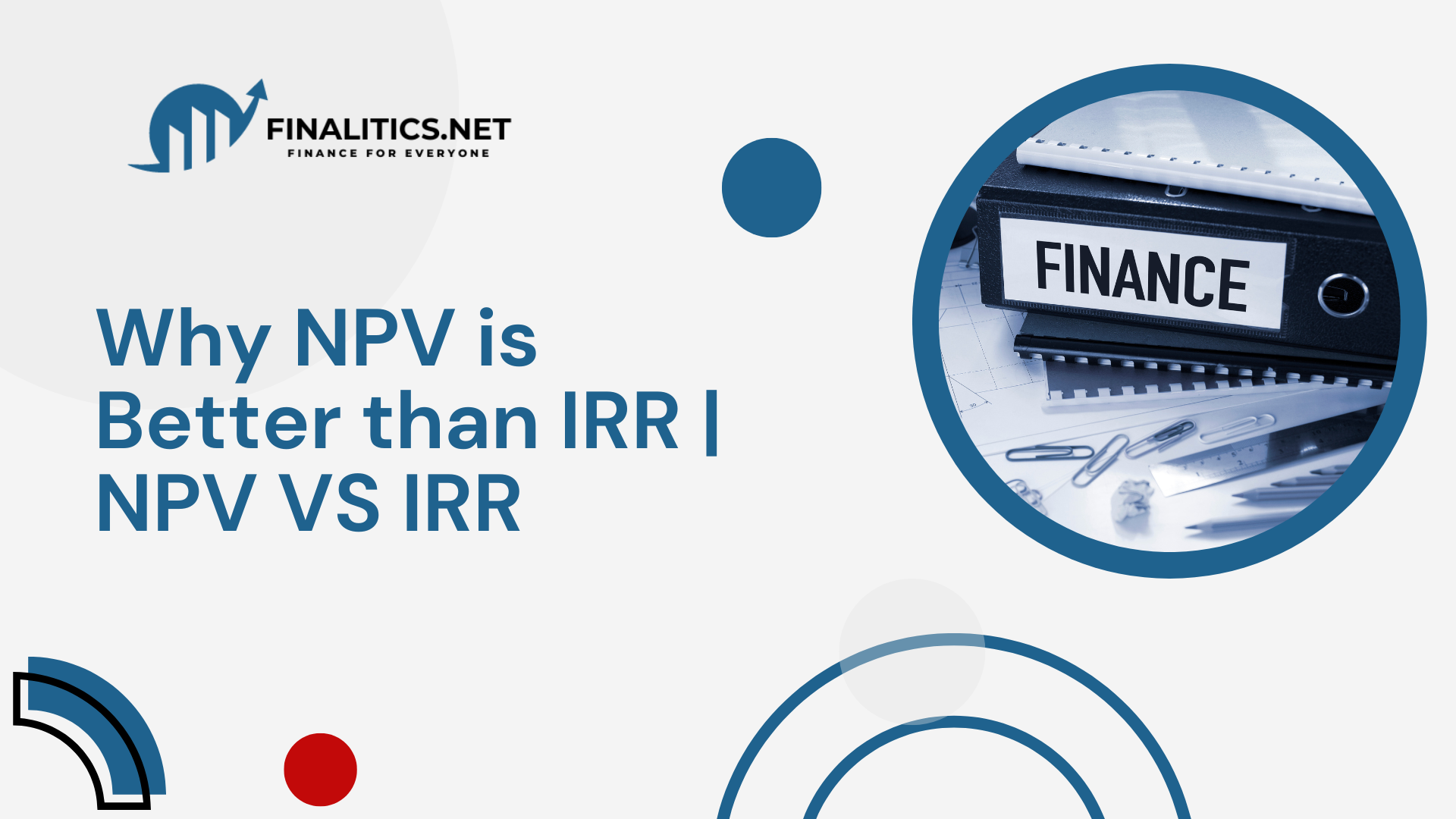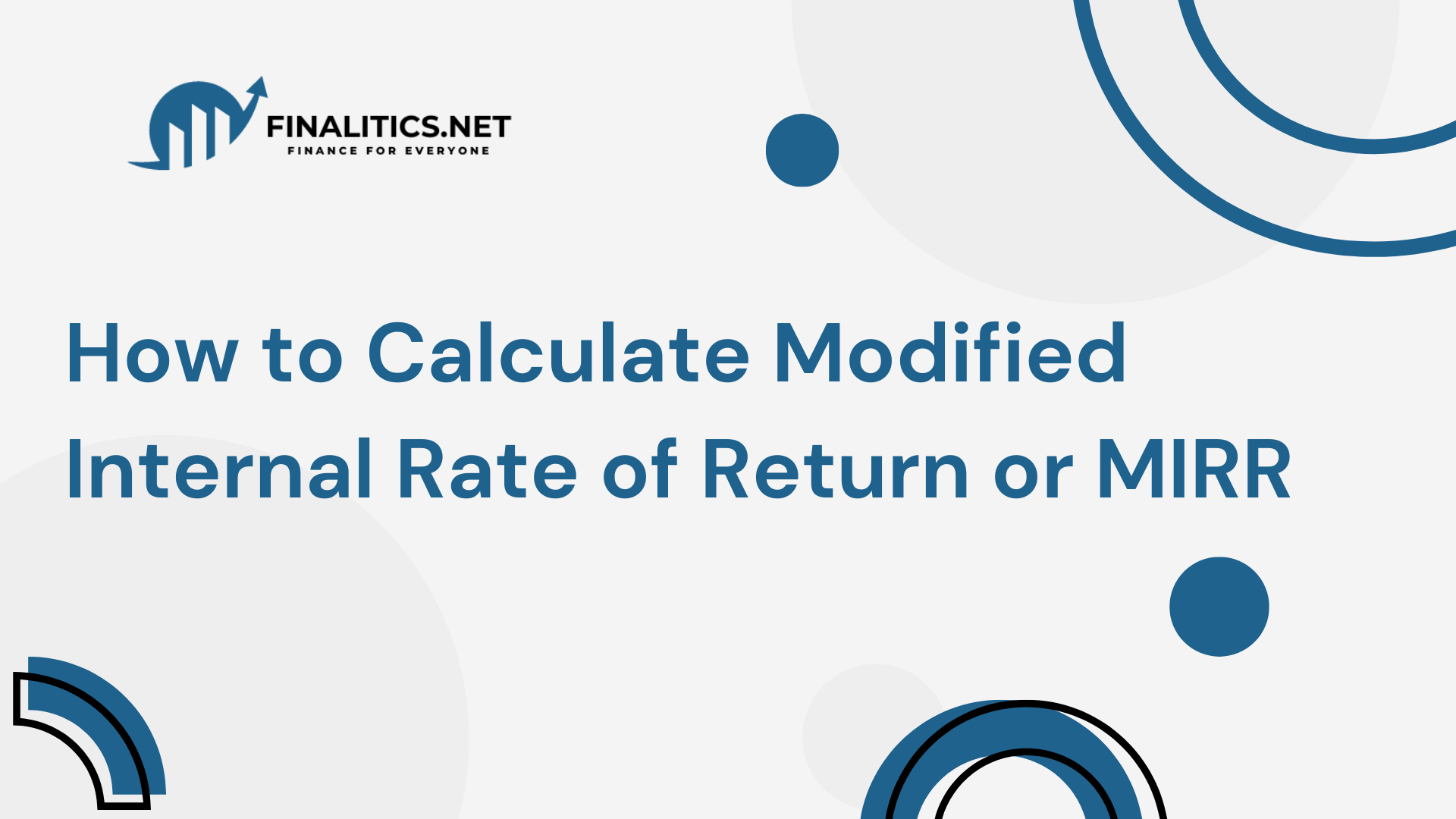In this blog, I will delve into the key reasons why NPV is better than IRR | NPV VS IRR, explaining both concepts in detail and using real-world examples to demonstrate how NPV avoids the pitfalls associated with IRR. By the end, you’ll understand why leading financial analysts and businesses favor NPV when making crucial investment decisions. Let’s get started!
Before reading the blog, you must understand the basic differences between NPV and IRR.
Difference Between NPV and IRR
NPV (Net Present Value)
Definition: NPV is a financial metric that calculates the value of a project or investment by considering the present value of its expected cash flows minus the initial investment.
Key Points:
- How it Works: It discounts future cash flows back to their present value using a specific rate (often the cost of capital).
- Decision Rule: If NPV is greater than 0, the investment is considered good; if it’s less than 0, it’s not a good choice.
- Focus: It tells you how much value the project adds to today’s money.
In the blog “How to Calculate Net Present Value (NPV),” I’ve explained the full method of NPV calculations and its decision criteria.
IRR (Internal Rate of Return)
Definition: IRR is the rate at which the NPV of a project becomes zero. In other words, the discount rate makes the present value of future cash flows equal to the initial investment.
Key Points:
- How it Works: It helps find the break-even point for the investment.
- Decision Rule: If the IRR is greater than the required rate of return (or cost of capital), the investment is considered good.
- Focus: It gives you a percentage that shows the profitability of the investment.
In the blog “How to Calculate Internal Rate of Return (IRR),” I’ve explained the full method of IRR calculation and its decision criteria.
Summary of Differences between NPV and IRR
- Purpose: NPV gives a dollar value, while IRR gives a percentage.
- Interpretation: NPV tells you how much money you’ll make; IRR tells you the rate of return you can expect.
- Decision Making: NPV is more straightforward for evaluating profitability, while IRR can sometimes be misleading, especially with projects with varying cash flows.
Choosing the right project evaluation method is crucial for a company’s success in corporate finance and investment decision-making. When a business considers investing in a new project, expansion, or any major capital expenditure, understanding the financial viability of that investment is essential. Two of the most commonly used methods for evaluating the profitability of such investments are Net Present Value (NPV) and Internal Rate of Return (IRR).
While both methods are valuable tools in their own right, they differ significantly in assessing a project’s profitability, and relying solely on one method over the other can lead to suboptimal decisions.
Many finance professionals still debate which method provides a clearer, more accurate picture of a project’s value. NPV is often regarded as the superior method for making well-informed financial decisions. Yet, many companies still default to using IRR due to its simplicity and the allure of a percentage-based return that seems easier to interpret.
However, this simplicity can be deceiving. IRR often leads to misleading results, especially when comparing projects of different sizes, when cash flows are unconventional, or when the reinvestment assumptions are unrealistic. On the other hand, NPV provides a more reliable measure of a project’s contribution to shareholder wealth by focusing on how much value a project adds in absolute dollar terms. It accounts for the time value of money, risk, and realistic reinvestment assumptions, giving decision-makers a clearer picture of whether a project will enhance the firm’s financial position.
Six basic reasons why NPV is better than IRR; you must know
1. Focus on Actual Value Added
NPV tells you how much actual dollar value a project will add to the company, while IRR only focuses on the rate of return, which may not reflect the true value.
Example: A company is deciding between two projects. Project A promises a 30% IRR and generates 5,000 dollars in value, while Project B promises a 20% IRR but generates 100,000 dollars in value.
Explanation: IRR might make Project A look better due to its higher return percentage, but NPV clearly shows that Project B adds far more actual value to the company (100,000 dollars vs. 5,000 dollars ). NPV provides a more meaningful number by showing the dollar value added, which IRR ignores.
2. Handling of Different Project Sizes
NPV gives a clearer picture of which project brings more value, even when the projects are of different sizes. IRR might favor smaller projects with higher rates of return but lower overall cash generation.
Example: Project X requires a 10,000-dollar investment and a 50% return, while Project Y requires a $500,000 investment and a 15% return.
Explanation: IRR favors Project X because of its high percentage return, but NPV shows that Project Y generates much more value due to its larger size. Even though Project Y’s IRR is lower, the absolute profit is significantly higher, which NPV captures.
3. Reinvestment Rate Assumptions
NPV assumes cash flows are reinvested at the firm’s cost of capital (WACC), which is a realistic assumption. IRR assumes reinvestment at the same high rate of return, which is often unrealistic.
Example: A project with a 40% IRR assumes that all cash flows are reinvested at 40%. However, realistically, the company can only reinvest cash at its 10% cost of capital (WACC).
Explanation: NPV assumes reinvestment at the realistic WACC (10%), while IRR makes an unrealistic assumption that cash flows can keep earning 40%. Using IRR can lead to overestimating a project’s profitability, whereas NPV gives a more grounded assessment.
4. Multiple IRRs Problem
Some projects can have more than one IRR, especially when cash flows change direction (positive to negative or vice versa) more than once. This creates confusion, but NPV avoids this issue entirely by focusing on value.
Example: A project has an initial outflow of 50,000, a positive inflow of 100,000, and a negative cash flow of 20,000. This gives two IRRs: 10% and 50%.
Explanation: Multiple IRRs can create confusion, as it’s unclear which rate to use for decision-making. NPV avoids this problem entirely, providing one clear value reflecting the project’s true worth.
5. Clearer Decision Making for Mutually Exclusive Projects
When choosing between mutually exclusive projects, NPV clearly shows which project adds more value, whereas IRR might lead to wrong choices if the rates of return differ greatly but the actual cash generated is not as high.
Example: A company can invest in either Project A or B but not both. Project A has an IRR of 30% and adds 50,000 dollars in value, while Project B has an IRR of 25% but adds 150,000 dollars in value.
Explanation: NPV shows that Project B is the better choice because it adds more value (150,000 dollars vs. 50,000 dollars), even though its lower IRR. IRR might mistakenly lead to choosing Project A due to the higher percentage, but NPV focuses on total value added.
6. No Ambiguity
NPV provides a definitive value for whether a project should be accepted or rejected. At the same time, IRR can sometimes offer multiple or confusing results, especially in non-normal cash flow situations.
Example: A project has irregular cash flows, leading to an IRR of 10% in one case and 100% in another due to cash flow patterns.
Explanation: IRR’s multiple possible values create ambiguity. NPV, however, provides a single, clear value that indicates whether the project should be accepted or rejected, making it easier for decision-makers to move forward without confusion.
These are the main reasons why NPV is better than IRR.
Let me know in the comment box if you’re still confused.
Final Thoughts
When making critical investment decisions, choosing the right financial metric can significantly impact a company’s profitability and long-term success. While net present value (NPV) and internal rate of return (IRR) are widely used in capital budgeting, NPV is the most reliable, accurate, and insightful method.
Unlike IRR, which can be misleading due to its reliance on percentage-based returns, NPV provides a clear dollar value that directly reflects how much a project will contribute to a company’s wealth. It effectively handles projects of different sizes, avoids multiple IRR confusion, and makes realistic reinvestment rate assumptions, ensuring sound financial decision-making.
By focusing on actual value addition rather than just return percentages, NPV helps businesses prioritize projects that maximize shareholder wealth, leading to better resource allocation and higher profitability. This is why leading financial experts and organizations favor NPV over IRR when evaluating investments.
In summary, NPV is the best choice if you want a precise, transparent, and effective approach to capital budgeting. Have any questions? Drop them in the comments, and let’s discuss!
FAQ
1. Why is NPV considered better than IRR for investment decision-making?
NPV is preferred because it provides a clear dollar value that represents the actual profitability of a project. Unlike IRR, which can be misleading due to multiple IRRs, unrealistic reinvestment assumptions, and its reliance on percentage-based returns, NPV offers a more reliable and accurate measure of a project’s contribution to a company’s financial growth.
2. What is the biggest drawback of using IRR instead of NPV?
One of the major drawbacks of IRR is that it can give multiple values when a project has non-conventional cash flows (i.e., cash flows that switch between positive and negative). This creates confusion in decision-making. Additionally, IRR assumes that all intermediate cash flows are reinvested at the IRR itself, which is often unrealistic. In contrast, NPV assumes reinvestment at the cost of capital, making it a more practical approach.
3. Can IRR and NPV give different decisions for the same project?
Yes, in some cases, IRR and NPV can lead to different investment decisions, especially for mutually exclusive projects. IRR might favor projects with higher percentage returns but lower overall value, whereas NPV identifies the project that generates the most wealth in absolute terms. In such cases, NPV provides the more financially sound decision.
4. When is IRR still useful despite its limitations?
IRR can be useful when comparing projects with similar investment sizes and cash flow patterns. It is also helpful in quickly assessing the efficiency of an investment, as many investors and managers find it easier to interpret a percentage return. However, for complex financial decisions, large-scale investments, and mutually exclusive projects, NPV is the superior choice.
5. How does NPV account for the time value of money better than IRR?
NPV discounts all future cash flows at a realistic discount rate (cost of capital), ensuring that future cash inflows are adjusted for inflation, risk, and capital costs. This makes it a more accurate representation of the project’s true profitability. IRR, on the other hand, simply finds a break-even discount rate and does not explicitly show how much wealth will be created in dollar terms.


